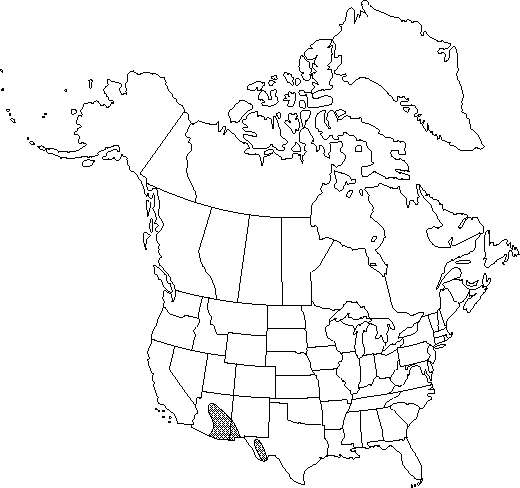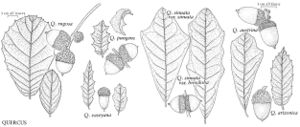Difference between revisions of "Quercus rugosa"
Anales Ci. Nat. 3: 275. 1801.
FNA>Volume Importer |
FNA>Volume Importer |
||
| Line 39: | Line 39: | ||
}}<!-- | }}<!-- | ||
| − | --><span class="statement" id="st- | + | --><span class="statement" id="st-undefined" data-properties=""><b>Shrubs </b>or trees, evergreen, usually moderate-sized, rarely large. <b>Bark</b> light or dark brown, scaly. <b>Twigs</b> brown, turning gray with age, 1-2 mm diam., tomentose to tomentulose, variously glabrate or persistently pubescent. <b>Buds</b> brown, ovoid, 2-4 mm, apex obtuse, sparsely pubescent or eventually glabrate. <b>Leaves</b>: petiole to 7 mm. <b>Leaf</b> blade broadly obovate or panduriform to orbiculate or elliptic, rarely narrowly obovate, usually cupped, strongly concave proximally, sometimes planar, to 100 × 70 mm, stiff, leathery, base deeply or shallowly cordate, margins usually somewhat revolute, cartilaginously thickened, undulately crisped or flat with inconspicuous or coarse mucronate teeth near apex, secondary veins 8-10(-12) on each side, branched, apex broadly rounded, rarely subacute; surfaces abaxially dull, glaucous, or densely brownish tomentose, becoming nearly glabrate or pubescence persistent, especially about midribs, secondary veins very prominently raised, reticulate, adaxially dark green, lustrous, sparsely stellate-pubescent especially about base of midrib, secondary veins impressed. <b>Acorns</b> 1-3 or more on slender axillary peduncle 30-60 mm; cup deeply cup-shaped to saucer-shaped, to 9 mm deep × 15 mm wide, enclosing to 1/2 nut, scales loosely appressed, characteristically somewhat spreading, brown, ovate, tuberculate-thickened or only slightly so, tomentose or obscurely tomentulose; nut light brown, ovoid to elliptic, to 20 × 15 mm, glabrous or minutely villous. <b>Cotyledons</b> distinct, often reddish or purple.</span><!-- |
-->{{Treatment/Body | -->{{Treatment/Body | ||
| Line 45: | Line 45: | ||
|habitat=Wooded slopes | |habitat=Wooded slopes | ||
|elevation=2000-2500 m | |elevation=2000-2500 m | ||
| − | |distribution=Ariz.;N.Mex.;Tex.;Mexico;Central America (Guatemala) | + | |distribution=Ariz.;N.Mex.;Tex.;Mexico;Central America (Guatemala). |
|discussion=<p>Quercus rugosa occurs on wooded slopes at high elevations in trans-Pecos Texas, southern New Mexico, and Arizona, and throughout most of the mesic montane parts of Mexico, south to Guatemala.</p> | |discussion=<p>Quercus rugosa occurs on wooded slopes at high elevations in trans-Pecos Texas, southern New Mexico, and Arizona, and throughout most of the mesic montane parts of Mexico, south to Guatemala.</p> | ||
|tables= | |tables= | ||
| Line 65: | Line 65: | ||
|habitat=Wooded slopes | |habitat=Wooded slopes | ||
|elevation=2000-2500 m | |elevation=2000-2500 m | ||
| − | |distribution=Ariz.;N.Mex.;Tex.;Mexico;Central America (Guatemala) | + | |distribution=Ariz.;N.Mex.;Tex.;Mexico;Central America (Guatemala). |
|reference=None | |reference=None | ||
|publication title=Anales Ci. Nat. | |publication title=Anales Ci. Nat. | ||
|publication year=1801 | |publication year=1801 | ||
|special status=Selected by author to be illustrated | |special status=Selected by author to be illustrated | ||
| − | |source xml=https://jpend@bitbucket.org/aafc-mbb/fna- | + | |source xml=https://jpend@bitbucket.org/aafc-mbb/fna-data-curation.git/src/9216fc802291cd3df363fd52122300479582ede7/coarse_grained_fna_xml/V3/V3_508.xml |
|genus=Quercus | |genus=Quercus | ||
|section=Quercus sect. Quercus | |section=Quercus sect. Quercus | ||
|species=Quercus rugosa | |species=Quercus rugosa | ||
| − | |||
| − | |||
| − | |||
| − | |||
| − | |||
| − | |||
| − | |||
| − | |||
| − | |||
| − | |||
| − | |||
| − | |||
| − | |||
| − | |||
| − | |||
| − | |||
| − | |||
| − | |||
| − | |||
| − | |||
| − | |||
| − | |||
| − | |||
| − | |||
| − | |||
| − | |||
| − | |||
| − | |||
| − | |||
| − | |||
| − | |||
| − | |||
| − | |||
| − | |||
| − | |||
| − | |||
| − | |||
| − | |||
| − | |||
| − | |||
| − | |||
| − | |||
| − | |||
| − | |||
| − | |||
| − | |||
| − | |||
| − | |||
| − | |||
| − | |||
| − | |||
| − | |||
| − | |||
| − | |||
| − | |||
| − | |||
| − | |||
| − | |||
| − | |||
}}<!-- | }}<!-- | ||
-->[[Category:Treatment]][[Category:Quercus sect. Quercus]] | -->[[Category:Treatment]][[Category:Quercus sect. Quercus]] | ||
Revision as of 13:42, 27 July 2019
Shrubs or trees, evergreen, usually moderate-sized, rarely large. Bark light or dark brown, scaly. Twigs brown, turning gray with age, 1-2 mm diam., tomentose to tomentulose, variously glabrate or persistently pubescent. Buds brown, ovoid, 2-4 mm, apex obtuse, sparsely pubescent or eventually glabrate. Leaves: petiole to 7 mm. Leaf blade broadly obovate or panduriform to orbiculate or elliptic, rarely narrowly obovate, usually cupped, strongly concave proximally, sometimes planar, to 100 × 70 mm, stiff, leathery, base deeply or shallowly cordate, margins usually somewhat revolute, cartilaginously thickened, undulately crisped or flat with inconspicuous or coarse mucronate teeth near apex, secondary veins 8-10(-12) on each side, branched, apex broadly rounded, rarely subacute; surfaces abaxially dull, glaucous, or densely brownish tomentose, becoming nearly glabrate or pubescence persistent, especially about midribs, secondary veins very prominently raised, reticulate, adaxially dark green, lustrous, sparsely stellate-pubescent especially about base of midrib, secondary veins impressed. Acorns 1-3 or more on slender axillary peduncle 30-60 mm; cup deeply cup-shaped to saucer-shaped, to 9 mm deep × 15 mm wide, enclosing to 1/2 nut, scales loosely appressed, characteristically somewhat spreading, brown, ovate, tuberculate-thickened or only slightly so, tomentose or obscurely tomentulose; nut light brown, ovoid to elliptic, to 20 × 15 mm, glabrous or minutely villous. Cotyledons distinct, often reddish or purple.
Phenology: Flowering early–late spring.
Habitat: Wooded slopes
Elevation: 2000-2500 m
Distribution

Ariz., N.Mex., Tex., Mexico, Central America (Guatemala).
Discussion
Quercus rugosa occurs on wooded slopes at high elevations in trans-Pecos Texas, southern New Mexico, and Arizona, and throughout most of the mesic montane parts of Mexico, south to Guatemala.
Selected References
None.
